29 Ways To Get Rid Of Razor Bumps Effectively At Home
Simple remedial methods to smoothen your skin and erase the mounds of ingrown hair.

Image: Shutterstock
Shaving undesired body hair often results in tiny bumps on your skin called razor bumps. It is one of the common challenges many of us face, especially while shaving hair from the body and bikini region. Do you want to know how to get rid of razor bumps? Are razor bumps a cause of concern? Let us find that out first.

A razor bump, also known as Pseudofolliculitis Barbae or barber’s itch, is a skin irritation caused by shaving your hair from sensitive areas. It is more common in areas with curly hair growth because after shaving, instead of growing out of the follicles, the curly hair strands tend to grow inwards, resulting in infections, pain, inflammation, redness, itchiness, pimples, scarring, pustules, and other skin conditions. However, the best solution for this condition is preventing them (1), (2). Read on to know how to get rid of razor bumps easily.
In This Article
Understanding Razor Bumps
Razor bumps are small, irritated bumps on the skin that appear after shaving. These can occur in areas with curly or coarse hair. They are caused by hairs curling back into the skin. They lead to inflammation, redness, and discomfort. Following proper shaving techniques, moisturizing, and using sharp, clean razors can help prevent them.
However, if you already have them or are prone to getting razor bumps, here’s how you can get rid of them. Scroll down!
Key Takeaways
- A razor bump is skin irritation caused by shaving hair off sensitive areas on the body. It is common in areas with curly hair as they become ingrown, leading to infection and inflammation
- Try topically applying natural remedies like aloe vera, diluted tea tree oil, honey, or witch hazel extract to soothe a razor bump.
- A deodorant stick, rubbing alcohol, aspirin paste, and cold compress may also help relieve pain from razor bumps.
- Antibacterial, glycolic, hydrocortisone, or Retin A creams may help treat razor bumps.
- A few tips you can follow to prevent razor bumps are wearing comfortable underwear, not picking at the bumps, and using new and clean razors.
How To Get Rid Of Razor Bumps
1. Aloe Vera For Razor Bumps
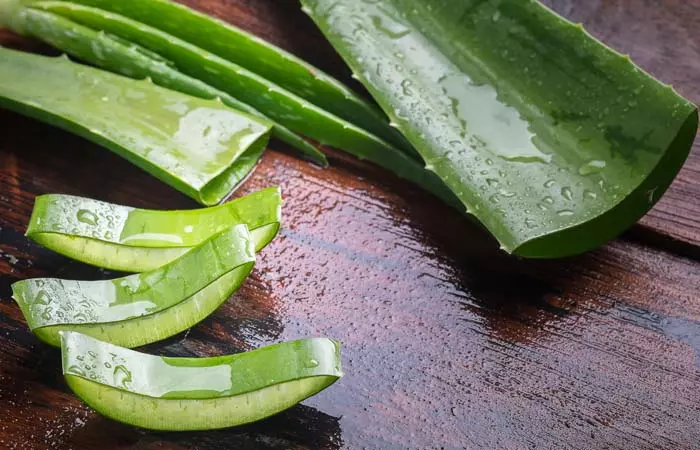
You Will Need
Fresh aloe vera gel
What You Have To Do
- Extract fresh gel from an aloe vera leaf and apply this on the affected area.
- Let it dry for a couple of minutes.
- Rinse with cool water and pat dry.
How Often You Need To Do This
Repeat this twice or thrice a day.
Why This Works
Application of aloe vera is the best way to get rid of razor bumps. When applied on bumps, it soothes the skin and reduces inflammation and irritation. It also contains mucopolysaccharidesi Sugar molecule chains found throughout the body, in the mucous and the fluid around joints, that work as lubricants. that moisturize the skin. Its antiviral and antiseptic components will prevent the development of any infection at the site of the razor bumps (3).
 Quick Tip
Quick Tip2. Tea Tree Oil To Get Rid Of Razor Bumps
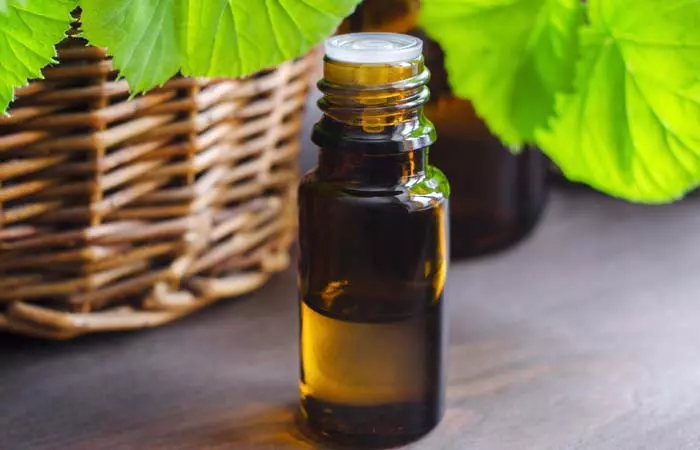
You Will Need
- A few drops of tea tree oil
- 1 tablespoon of olive oil
What You Have To Do
- Mix the tea tree essential oil in the carrier oil and apply this mixture on the razor bumps.
- Leave it on for 10 to 15 minutes.
- Rinse with warm water.
How Often You Need To Do This
Do this twice a day till you get relief from the razor bumps.
Why This Works
Tea tree oil is a multipurpose essential oil with antimicrobial, antioxidant, and anti-inflammatory properties.
It will reduce the swelling caused by the razor bump and also treat any infections that may be aggravating the problem (4).
3. Witch Hazel For Razor Bumps
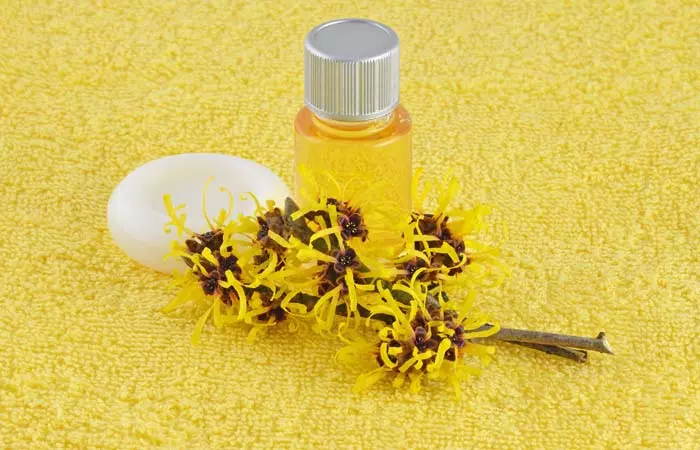
You Will Need
A few drops of witch hazel extract
What You Have To Do
- Apply this directly to the affected area and let it dry.
- Leave it on.
How Often You Need To Do This
Apply this twice or thrice a day.
Why This Works
The tannins present in witch hazel act as an astringent. The other components of this herb reduce redness and inflammation and are antibacterial in nature (5).
4. Honey For Razor Bumps
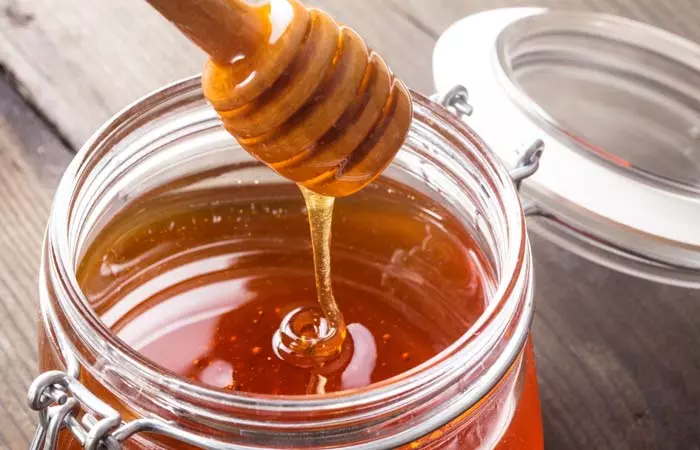
You Will Need
- 1/2 teaspoon honey
- 1 tablespoon plain yogurt
What You Have To Do
- Mix the two ingredients and apply the mixture to the razor bumps.
- Let it air dry for about 15 minutes.
- Rinse with lukewarm water.
You can also apply only honey.
How Often You Need To Do This
Repeat this twice a day.
Why This Works
Honey is a humectant and emollient. It soothes the skin while moisturizing it, and is also antibacterial in nature (6). The probiotics present in yogurt will calm the irritation and alleviate itching and redness (7). This is one of the best home remedies for razor bump relief.
5. Apple Cider Vinegar For Razor Bumps
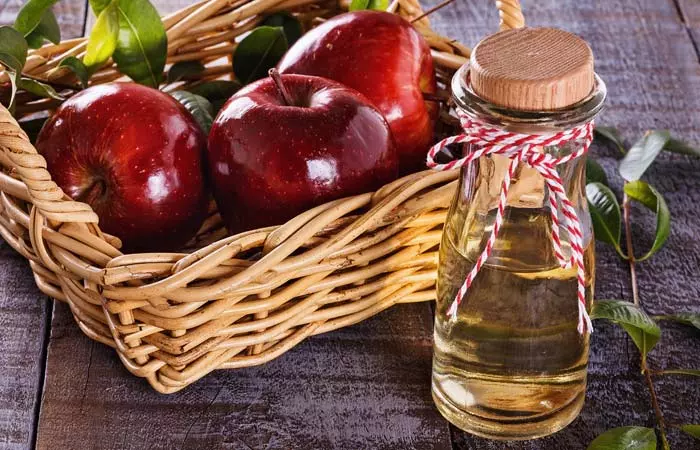
You Will Need
- Apple cider vinegar
- Cotton ball
What You Have To Do
- Dip the cotton ball in the vinegar and apply it to the razor bumps.
- Leave it on to air dry.
How Often You Need To Do This
Apply this three to four times a day.
Why This Works
The list of uses of apple cider vinegar is endless. When it comes to getting rid of razor bumps, ACV works really well. It has antimicrobial and anti-inflammatory properties that reduce swelling and itching and also effectively kill any bacteria (8).
Caution
If you have sensitive skin, dilute the ACV in water in the ratio 1:3 and then apply.
6. Deodorant To Get Rid Of Razor Bumps
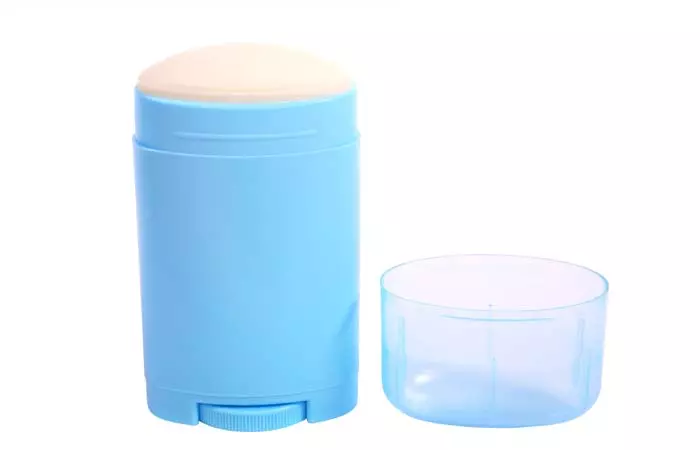
You Will Need
Deodorant stick
What You Have To Do
After you finish shaving, clean the area and liberally rub a deodorant stick over it.
How Often You Need To Do This
Do this every time you shave.
Why This Works
Rubbing a deodorant over the shaved area will keep it dry and free of bacteria (9). This will prevent chafing and the development of razor bumps. This technique works well for razor bumps along the bikini line.
Caution
Do not use gel, liquid, or spray deodorants.
7. Lemon Juice For Razor Bumps

You Will Need
- Lemon juice
- Cotton ball
What You Have To Do
- With the help of the cotton ball, apply lemon juice to the affected area.
- Let it air dry.
- Once dried, wash off with lukewarm water.
How Often You Need To Do This
Repeat this every time after you shave to prevent razor bumps.
Why This Works
Lemon, due to its acidic nature, is antibacterial and antifungal. Applying it on the razor bumps will kill any microbes present and aid quick healing. Lemon also lightens the skin and reduces scarring (10).
8. Baking Soda To Prevent Razor Bumps
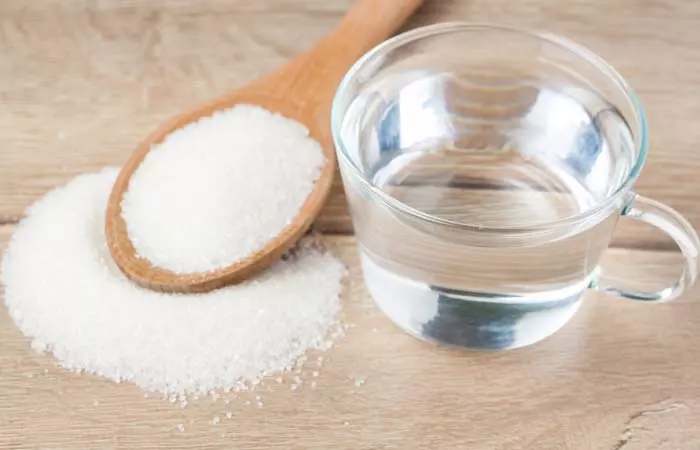
You Will Need
- 1 tablespoon baking soda
- A cup of water
- Cotton ball
What You Have To Do
- Mix the baking soda in the water and apply this water to the affected area using the cotton ball.
- Let it dry for a few minutes. Then, rinse with cool water.
How Often You Need To Do This
Repeat this twice or thrice a day.
Why This Works
Baking soda is anti-inflammatory in nature and soothes the irritated razor bumps. It neutralizes the skin’s pH and also kills bacteria (11).
9. Rubbing Alcohol To Prevent Razor Bumps
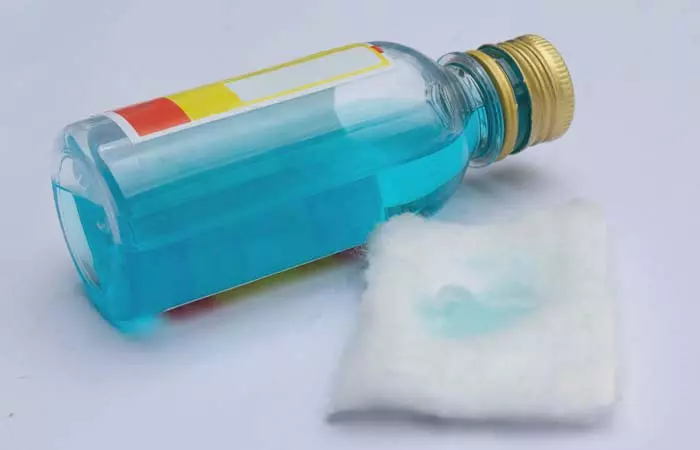
You Will Need
- 1 tablespoon rubbing alcohol
- Cotton ball
What You Have To Do
- Apply the alcohol on the razor bumps using the cotton ball.
- Let it air dry.
How Often You Need To Do This
Apply this twice a day till you get relief from razor bumps.
Why This Works
Alcohol is a widely used disinfectant. It will kill any microbes present on your razor bumps and aid in quicker healing (12).
10. Aspirin Paste For Razor Bumps
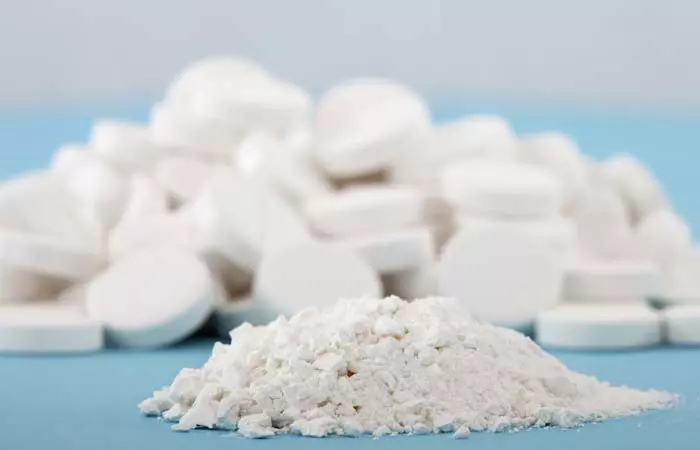
You Will Need
- 4-5 aspirin tablets
- Water
What You Have To Do
- Crush the aspirin tablets and mix with water to form a paste.
- Apply this on the affected area and let it dry for 10-12 minutes.
- Rinse with lukewarm water.
How Often You Need To Do This
Repeat this once or twice a day.
Why This Works
Aspirin works quickly and efficiently in healing razor bumps because of its anti-inflammatory properties (13).
11. Castor Oil For Razor Bumps

You Will Need
A few drops of castor oil
What You Have To Do
- Clean the affected area and gently apply castor oil to it in a massaging motion.
- Do not wipe or wash away the oil.
How Often You Need To Do This
Repeat this twice a day.
Why This Works
Castor oil nourishes the skin, removes dead cells, and also kills bacteria. It also aids in lightening the ingrown hair scars that may have formed as it possesses antioxidants that heal the skin (14, 15, 16).
12. White Tea For Razor Bumps
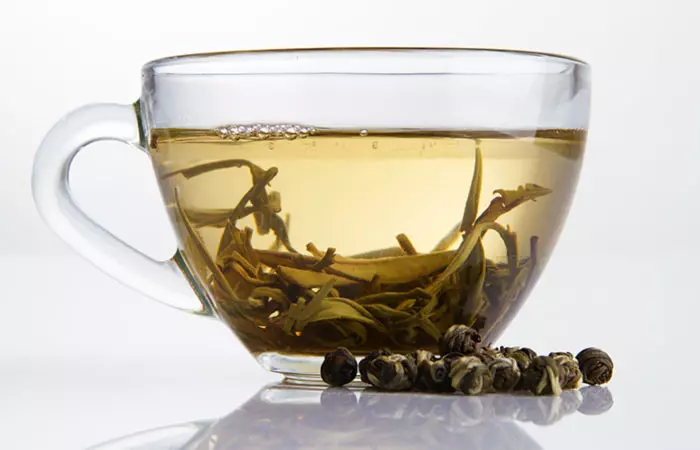
You Will Need
White tea bag
What You Have To Do
- Dip a white tea bag into a cup of lukewarm water.
- Gently strain the water out.
- Place the tea bag on the affected area for two minutes.
- Pat dry.
How Often You Need To Do This
Repeat this twice a day.
Why This Works
White tea contains tannic acid, which a natural anti-inflammatory agent. Applying the white tea bag on the affected area will help to soothe the affected area and reduce swelling and pain (5).
13. Black Tea To Get Rid Of Razor Bumps
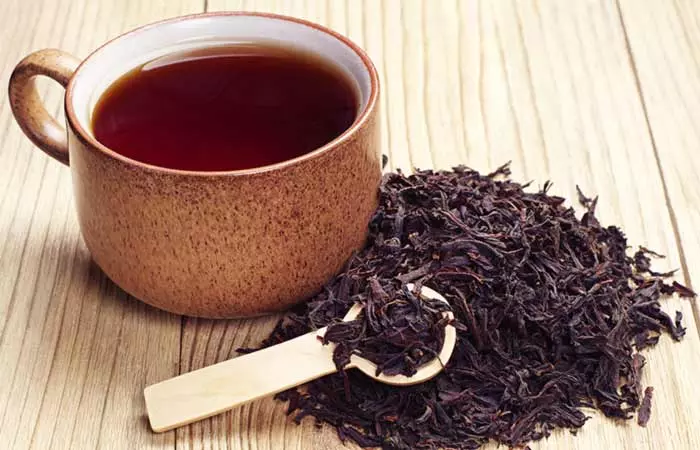
You Will Need
Tea bag
What You Have To Do
- Moisten a tea bag and keep it in the refrigerator for 10 minutes.
- Apply the tea bag on the affected area for about five minutes.
- Rinse the area with cold water and pat dry.
- Apply medicated moisturizer (bikini area).
How Often You Need To Do This
Do this four to five times a day.
Why This Works
The tanninsi Water-soluble plant compounds that have several industrial, cosmetic, and medicinal applications. present in black tea are natural astringents and help to reduce swelling, redness, and pain (17). The refrigerated tea bag helps to soothe an itchy razor bump.
14. Cold/Hot Compress To Prevent Razor Bumps
You Will Need
- Towel
- A bowl of moderately hot water
- A bowl of refrigerated water
What You Have To Do
- For a cold compress, dip the towel into the bowl of refrigerated water.
- Gently squeeze out the water and apply the towel to the affected area for about a minute. Repeat this for about five times.
- For a hot compress, dip the towel into the bowl of moderately hot water and apply the compress to the affected area for about two minutes.
- Repeat this five times.
- Moisturize your skin.
How Often You Need To Do This
Apply the hot or cold compress twice daily.
Why This Works
A cold compress helps to reduce the itchiness of the razor bumps by numbing the nerve endings. Using a cold compress right after shaving will help prevent razor bumps. Hot compress helps to treat razor bumps by opening the skin pores and freeing the trapped ingrown hair.
15. Cornstarch For Razor Bumps
You Will Need
- 2-3 tablespoons cornstarch
- Water
- Cotton pads
What You Have To Do
1. Mix the cornstarch and water to make a thick paste.
2. Apply this paste on the affected area and
3. leave it for 15-20 minutes.
4. Gently remove the paste by using moistened cotton pads.
5. Apply moisturizer.
How Often You Need To Do This
Do this twice daily or right after shaving to prevent razor bumps.
Why This Works
Cornstarch may help reduce itchiness, irritation, and redness. According to anecdotal evidence, it provides a layer of protection when used right after shaving, thus preventing the formation of a razor bump.
16. Baby Powder For Razor Bumps
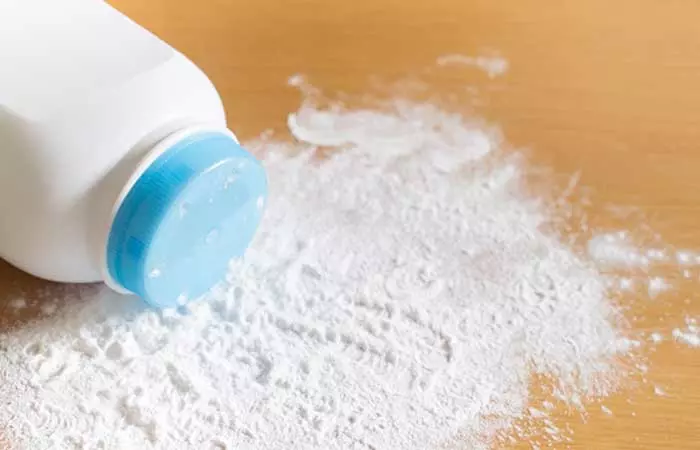
You Will Need
Baby powder
What You Have To Do
Sprinkle baby powder on your skin before shaving.
How Often You Need To Do This
Do this every time before you shave.
Why This Works
Baby powder is often used to prevent diaper rashes in babies. Anecdotal evidence also suggests it is effective in preventing razor bumps or rashes on the skin and in helping to keep the skin dry.
17. Coconut Oil To Get Rid Of Razor Bumps
You Will Need
- Coconut oil
- Cotton ball
What You Have To Do
- Dip a clean cotton ball in the oil and dab it on the affected area.
- Leave it on for 15 minutes.
- Rinse with cold water and pat dry.
How Often You Need To Do This
Repeat it twice a day.
Why This Works
Coconut oil is used to treat various skin infections and diseases. It helps to soften the skin, reduce inflammation and redness, and heal the affected area quickly (18).
18. Strawberry Paste For Razor Bumps
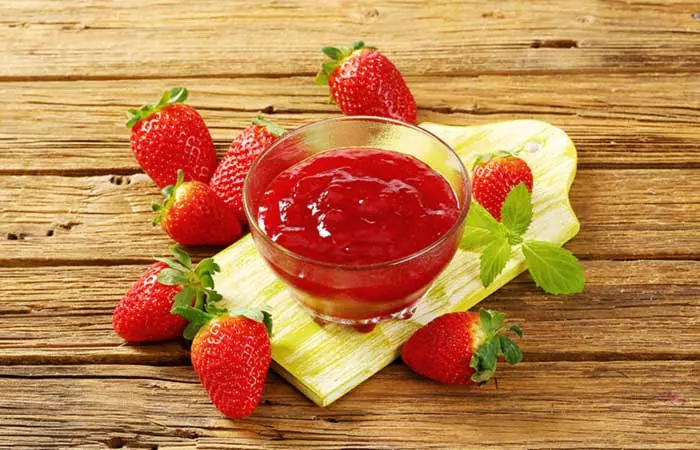
You Will Need
- Strawberries
- Mortar and pestle
What You Have To Do
- Use the mortar and pestle to roughly crush the strawberries.
- Refrigerate it for 10 minutes.
- Apply it on the affected area and
- leave it on for about 10 minutes.
- Rinse off with moderately cold water and pat dry.
- Apply moisturizer.
How Often You Need To Do This
Repeat this two times a day.
Why This Works
Strawberries are rich in vitamin C, folic acid, and fiber. These micronutrients help to scavenge the free oxygen radicals, flush out toxins, and help in cell regeneration. These characteristics of strawberries are essential for most skin problems including razor bumps as the strawberry paste helps to reduce redness, regenerate broken skin cell tissues in the affected area, and prevent skin infections.
19. Sugar Scrub To Prevent Razor Bumps
You Will Need
- 1 tablespoon sugar
- 1 tablespoon coconut oil
- A clean and soft tissue
What You Have To Do
- Heat the coconut oil a little and
- mix the sugar in it.
- Rub it in circular motions on the affected area for two minutes.
- Wipe off with a clean and soft tissue.
How Often You Need To Do This
Do this daily two hours after shaving and before going to bed.
Why This Works
The warm coconut oil and sugar mixture helps to open the pores of the skin and free the ingrown hair. It also helps to reduce swelling, redness, and pain in the affected area.
20. Oatmeal For Razor Bumps
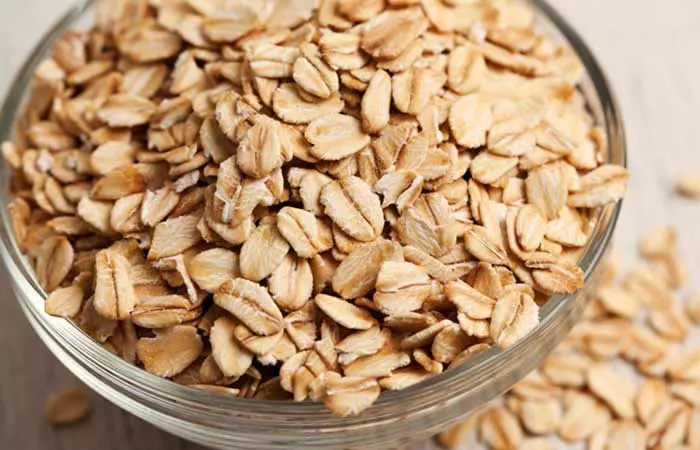
You Will Need
- 1 tablespoon ground oatmeal
- 1/2 tablespoon yogurt
- 1 teaspoon honey
What You Have To Do
1. Mix all the ingredients to form a paste.
2. Apply this paste on the affected area and leave it on for 10 minutes.
3. Wash off with cold water and pat dry.
4. Apply moisturizer.
How Often You Need To Do This
Do this twice daily to get quick results.
Why This Works
Oatmeal, yogurt, and honey have anti-inflammatory, antibacterial, and skin-soothing properties, which make them suitable ingredients to treat razor bumps (19), (20).
21. Cucumber And Milk For Razor Bumps
You Will Need
- 1 tablespoon pureed cucumber
- 2 tablespoons milk
What You Have To Do
- Mix the cucumber puree and milk in a small bowl.
- Refrigerate for at least 15 minutes.
- Apply this on the affected area and leave it on for 15 minutes.
- Wash off with cold water.
- Apply moisturizer.
How Often You Need To Do This
Repeat this twice or thrice daily to get the desired results.
Why This Works
This natural pack made up of milk and cucumber will help to reduce inflammation, prevent bacterial infection, and cool the affected area (21), (22).
22. Essential Oil To Get Rid Of Razor Bumps
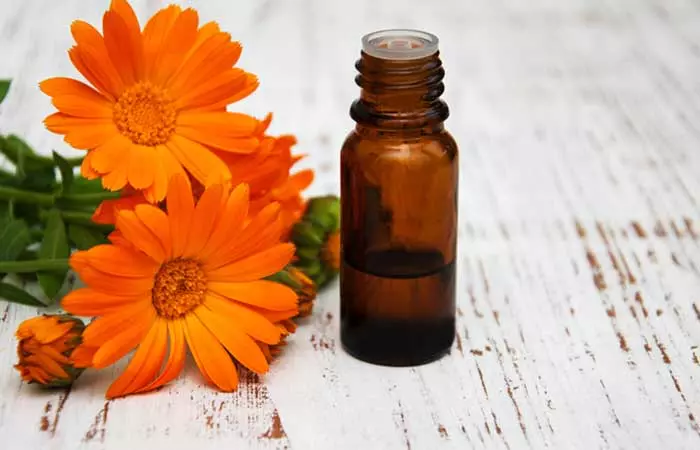
You Will Need
- 1 drop of lavender essential oil
- 1 drop of calendula essential oil
- 1/4 cup water
- Clean cotton ball
What You Have To Do
1. Mix the ingredients and refrigerate the mixture for 15 minutes.
2. Dip the cotton ball in the mixture and dab it on the affected area.
3. Leave it on for 10 minutes.
4. Wipe with a clean and soft tissue paper.
How Often You Need To Do This
Do this three to four times daily until you get the desired results.
Why This Works
Essential oils help to soothe the skin, reduce swelling and redness, and protect the skin from further damage (23).
Medications To Treat Razor Bumps
Depending on the skin’s sensitivity, the nature of the blade, and the technique used to shave, some razor bumps are too painful and stubborn to go away. This is when you should switch to using medications containing benzoyl peroxide, salicylic acid, or glycolic acid to treat the razor bumps. Here is the list of a few medications that can be applied with ease and give quick relief from the ugly razor bumps.
23. Hydrocortisone Cream To Prevent Razor Bumps
You Will Need
- 1% hydrocortisone cream
- Cotton swab
What You Have To Do
1. Apply the hydrocortisone cream on the affected area with the help of a clean cotton swab.
2. Use the other side of the swab to apply it to a second razor bump area to prevent the spreading of infection, if any.
3. Leave it on for 20 minutes.
4. Wash off with cold water.
How Often You Need To Do This
Repeat this once or twice every day depending on the intensity of the swelling.
Why This Works
Hydrocortisone helps to reduce swelling, redness, irritation, and inflammation by constricting the blood vessels and restricting the flow of blood to the affected area. It works like magic with razor bumps.
24. Glycolic Cream To Prevent Razor Bumps
You Will Need
- Glycolic cream
- Cotton swab
What You Have To Do
- Gently dab the ointment on the affected area with the cotton swab.
- Leave it on for 20 minutes.
- Wash off with cold water.
How Often You Need To Do This
Repeat this once or twice a day for faster results.
Why This Works
Glycolic creams help to reduce skin discoloration, swelling, irritation, and skin tissue scarring due to razor bumps. They also help to improve the skin’s texture (infections. This may aggravate the redness and swelling. Antibacterial creams help ).
A blogger shared her shaving routine for sensitive skin, emphasizing the use of a glycolic acid toner to treat her razor bumps. She said, “I use this toner for my face as a “pimple killer” and it works amazingly for the bikini area in getting rid of redness and bumps the next day! I find I only need to use this the first night I shave as it is so effective (i).”
25. Antibacterial Creams For Razor Bumps
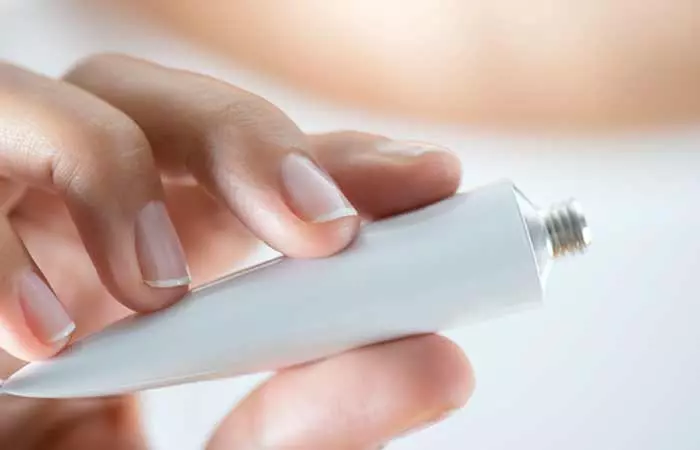
You Will Need
- Any antibacterial cream
- Cotton swab
What You Have To Do
- Apply a little antibacterial cream gently on the affected area with a cotton swab
- Leave it on for 20-30 minutes.
- Use a clean and soft tissue to wipe away the cream.
How Often You Need To Do This
Repeat this twice a day.
Why This Works
Razor bumps often cause skin tissue damage and can cause painful bacterial infections. This may aggravate the redness and swelling. Antibacterial creams help prevent the occurrence and spread of bacterial infection (25).
26. Retin A Cream For Razor Bumps
You Will Need
- Retin A cream
- Cotton swab
What You Have To Do
1. Dab a little Retin A ointment on the cotton swab and
2. apply it to the affected area.
3. Leave it on for 20 minutes.
4. Wipe it off with the help of a clean and soft tissue paper.
How Often You Need To Do This
Repeat this twice or thrice a day.
Why This Works
Retin A cream contains retinoidsi Synthetic and natural chemical compound that is functionally and structurally similar to vitamin A. that help to cure skin tissue damage and improve the skin’s texture (26). Applying this cream on a razor bump will help to even out the skin.
Caution
Breastfeeding and pregnant women are strictly not allowed to use this cream.
27. Alum Block To Prevent Razor Bumps
You Will Need
Small alum block
What You Have To Do
Rub the alum block on your skin right after shaving.
How Often You Need To Do This
Repeat this only after shaving.
Why This Works
Alum has antiseptic properties and prevents the occurrence and spread of infections by closing the skin pores. It also helps to prevent bleeding and scarring of skin tissue (28).
28. Exfoliating Scrub For Razor Bump
You Will Need
- 2 tablespoons of brown sugar
- 1 tablespoon of almond oil
- 3-4 drops of clove essential oil
- A clean tissue paper
What You Have To Do
1. Mix brown sugar with warm almond oil.
2. Add 3-4 drops of clove essential oil to the mixture.
3. Apply the scrub to the affected area.
4. Massage it in circular motions for two minutes.
5. Leave it on for another 5-10 minutes.
6. Wipe off the scrub with clean tissue paper.
How Often You Need To Do This
Do this once daily.
Why This Works
The brown sugar is abrasive and may help exfoliate the skin, and decongest the pores to release the ingrown hair. The sugar granules may also help in removing the dead skin cells and the almond oil helps moisturize the skin. Clove essential oil, on the other hand, exhibits antibacterial and anti-inflammatory properties that may reduce redness and inflammation (28).
29. Good Practices To Avoid Razor Bumps

- Wear Comfortable Underwear
Razor bumps can get infected if you do not wear comfortable underwear. Comfortable underwear made of natural fiber will help your skin breathe. Synthetic underwear traps sweat and causes the bacteria to thrive.
- Avoid Picking Or Scratching The Razor Bumps
These bumps resemble acne or pimples, but they are actually skin irritations. Hence, they should not be squeezed, picked, or scratched to keep the chances of infection and scarring at bay. Avoid shaving in the affected region for some days to allow the bumps to ebb.
- Avoid Using Old And Dirty Razors
Old and dirty razors contain microbes and can cause infections in sensitive areas. Also, old razors can make your skin more prone to cuts. Therefore, it is best to use a new razor every time you shave to prevent folliculitis.
- Use Disinfected Tweezers
Thin, disinfected tweezers can also be used to pull out or release the extra-follicular hair gently from within the skin, thereby inhibiting the development of these ugly bumps.
- Soften The Hair With Warm Water
Softening your hair with warm water before shaving will prevent the formation of razor bumps or cuts.
- Do Not Shave Against The Hair Growth Direction
Shaving against the direction of hair growth can lead to ingrown hair, irritated skin, and infected razor bumps. Always move the razor in the direction of the hair growth. Do not press the razor hard. After shaving, if you encounter various ingrown hair, it’s handy to know how to get rid of ingrown hair.
- Do Not Shave Too Frequently
Shaving too frequently can cause the skin to be inflamed, itchy, and red. This can lead to the spread of bacteria, which will ultimately lead to infected and painful razor bumps. Let the hair grow, and let the skin heal from the previous shave before you shave again.
- Use A Moisturizer To Soften Your Hair
If your hair grows thick in certain areas of your body, use a moisturizer to soften the hair follicles. This will prevent you from pressing the razor hard on your skin or using improper shaving techniques.
- Use Aftershave Lotion To Avoid Germs
Shaving can cause the hair follicles to open up or result in skin tissue damage. This can cause germs to enter the body and lead to infections. To avoid this, use an aftershave lotion that will disinfect the area right after shaving.
- Use Depilatories Or Hair Removal Creams
Depilatoriesi Chemical formulations that help dissolve hair and allow one to remove body hair easily. or hair removal creams contain chemicals that help to dislodge the hairs that are present on the skin. These creams gently remove the hair without being harsh on the skin, thereby helping to avoid razor bumps.
- Scrubbing Or Exfoliation
Scrubbing or exfoliation helps to remove dirt, microbes, and dead skin build-up from the epidermis, thereby giving way to a close and ideal shaving experience with no after-effects like shaving bumps. Hence, exfoliate regularly!
 Quick Tip
Quick Tip- Use Alcohol To Wash The Razor
Use alcohol to wash the razor before and after shaving. This will help prevent the spread of germs and infection.
Infographic: 6 Easy Ways To Treat Razor Bumps At Home
Razor bumps and ingrown hair might result from using a dull razor or shaving on bare skin without a shaving cream. They cause skin irritation and leave the skin feeling rough and bumpy. The good news is we have rounded up 6 natural remedies that may help treat razor bumps at home. Check out the infographic below to know more!

Illustration: StyleCraze Design Team
Shaving leads to razor bumps that can be itchy and red and may lead to inflammation, pain, infection, and other skin issues. You can opt for home remedies to reduce razor bumps, such as using tea tree oil, honey, witch hazel, or lemon juice. You can also try spraying deodorant or placing a cold/hot compress on the bumps. There are some creams that can also decrease razor bumps, such as antibacterial, glycolic, hydrocortisone, and retinoid creams. Following some simple hygienic practices, like not using old razors, can also prevent these razor bumps from appearing.
Frequently Asked Questions
What are the top products to prevent razor bumps?
The best products for preventing razor bumps include exfoliating scrubs, soothing shaving gels, and aftershave balms with salicylic acid or aloe vera. These can help reduce irritation, soften hair, and help prevent ingrown hairs.
Do razor bumps go away? If so, how long does it take?
Razor bumps can take any time between a week to 15 days to go away by themselves. However, this period can be longer or shorter, and depends a lot on your skin type and hygiene. It is advisable to use simple home remedies to heal these bumps quickly and not aggravate any infections.
Why do razor bumps itch and how to prevent itching?
Razor bumps can itch mainly due to three reasons:
1. You have used a dull razor and applied too much pressure on your skin, thus causing irritation and inflammation.
2. Shaving too close to the skin can damage the epidermis (top layer of skin) and cause intense itching and rashes.
3. Dry shaving can also cause the razor bumps to itch.
To prevent this annoying itching sensation, use a hydrating shaving gel or cream for shaving. You can also use coconut oil or olive oil. Always keep your skin well moisturized in between shaves.
Should I shave if I have razor bumps?
Avoid shaving the area if you have razor bumps. Wait till it clears up to avoid inflammation.
Should I pop my razor bumps?
No, popping the razor bumps can cause infection and leave a scar.
Does Vaseline help razor bumps?
Vaseline may not help treat razor bumps. However, you can apply it to soothe burning and itching sensations after shaving.
Can deodorant help razor bumps?
No. Deodorant may not help razor bumps. However, if you have razor bumps, you can apply an antiperspirant to reduce itching caused by sweat.
Does peroxide get rid of razor bumps?
No. Peroxide may help as a disinfectant but may not help get rid of razor bumps.
Does baby oil help razor burn?
Baby oil may help soothe the skin and reduce itching or burning after shaving. Therefore, you may apply it if you have razor burn.
Tired of razor bumps? Get the tips and tricks you need to get smooth, bump-free skin by clicking on the video below.
Personal Experience: Source
StyleCraze's articles are interwoven with authentic personal narratives that provide depth and resonance to our content. Below are the sources of the personal accounts referenced in this article.
i. Shaving Routine: Natural & Safehttps://beautywithinandout.wordpress.com/2016/12/19/shaving-routine-natural-safe/
References
Articles on StyleCraze are backed by verified information from peer-reviewed and academic research papers, reputed organizations, research institutions, and medical associations to ensure accuracy and relevance. Read our editorial policy to learn more.
- Pseudofolliculitis barbae
https://pubmed.ncbi.nlm.nih.gov/21034705/ - Treatment of pseudofolliculitis barbae with topical glycolic acid
https://pubmed.ncbi.nlm.nih.gov/8261811/ - ALOE VERA: A SHORT REVIEW
https://www.ncbi.nlm.nih.gov/pmc/articles/PMC2763764/ - Melaleuca alternifolia (Tea Tree) Oil: a Review of Antimicrobial and Other Medicinal Properties
https://www.ncbi.nlm.nih.gov/pmc/articles/PMC1360273/ - Antioxidant and potential anti-inflammatory activity of extracts and formulations of white tea, rose, and witch hazel on primary human dermal fibroblast cells
https://www.ncbi.nlm.nih.gov/pmc/articles/PMC3214789/ - Medicinal and cosmetic uses of Bee’s Honey
https://www.ncbi.nlm.nih.gov/pmc/articles/PMC3611628/ - The Role of Probiotics in Skin Health and Related Gut–Skin Axis
https://www.ncbi.nlm.nih.gov/pmc/articles/PMC10385652/ - Vinegar: Medicinal Uses and Antiglycemic Effect
https://www.ncbi.nlm.nih.gov/pmc/articles/PMC1785201/ - Deodorant effects of a sage extract stick: Antibacterial activity and sensory evaluation of axillary deodorancy
https://pubmed.ncbi.nlm.nih.gov/24497852/ - Phytochemical, antimicrobial, and antioxidant activities of different citrus juice concentrates
https://www.ncbi.nlm.nih.gov/pmc/articles/PMC4708628/ - Antibacterial activity of baking soda
https://pubmed.ncbi.nlm.nih.gov/12017929/ - Antiseptics and Disinfectants: Activity, Action, and Resistance
https://www.ncbi.nlm.nih.gov/pmc/articles/PMC88911/ - Aspirin in dermatology: Revisited
https://www.ncbi.nlm.nih.gov/pmc/articles/PMC4693360/ - Synthesis and evaluation of antioxidant and antifungal activities of novel ricinoleate-based lipoconjugates of phenolic acids
https://pubmed.ncbi.nlm.nih.gov/23442675/ - Final report on the safety assessment of Ricinus Communis (Castor) Seed Oil
https://pubmed.ncbi.nlm.nih.gov/18080873/ - Dirt-binding particles consisting of hydrogenated castor oil
https://pubmed.ncbi.nlm.nih.gov/19995365/ - Applications of Tea (Camellia sinensis) and Its Active Constituents in Cosmetics
https://www.ncbi.nlm.nih.gov/pmc/articles/PMC6930595/ - In vitro anti-inflammatory and skin protective properties of Virgin coconut oil
https://www.ncbi.nlm.nih.gov/pmc/articles/PMC6335493/ - Anti-inflammatory activities of colloidal oatmeal (Avena sativa) contribute to the effectiveness of oats in treatment of itch associated with dry, irritated skin
https://pubmed.ncbi.nlm.nih.gov/25607907/ - Bee Products in Dermatology and Skin Care
https://www.ncbi.nlm.nih.gov/pmc/articles/PMC7036894/ - Phytochemical and therapeutic potential of cucumber
https://pubmed.ncbi.nlm.nih.gov/23098877/ - More than skin deep: moisturizing body milk and Burkholderia cepacia
https://www.ncbi.nlm.nih.gov/pmc/articles/PMC2374588/ - Antibacterial Activity of Essential Oils from Palmarosa, Evening Primrose, Lavender and Tuberose
https://www.ncbi.nlm.nih.gov/pmc/articles/PMC2839398/ - Topical antibacterial agents for wound care: a primer
https://pubmed.ncbi.nlm.nih.gov/12786706/ - Topical Antibacterials in Dermatology
https://www.ncbi.nlm.nih.gov/pmc/articles/PMC8208253/ - Retinoids: active molecules influencing skin structure formation in cosmetic and dermatological treatments
https://www.ncbi.nlm.nih.gov/pmc/articles/PMC6791161/ - Antibacterial Activity of Syzygium aromaticum (Clove) Bud Oil and Its Interaction with Imipenem in Controlling Wound Infections in Rats Caused by Methicillin-Resistant Staphylococcus aureus
https://www.ncbi.nlm.nih.gov/pmc/articles/PMC9736006/
Read full bio of Dr. Swati Mutha
Read full bio of Arshiya Syeda
Read full bio of Ramona Sinha
Read full bio of Monomita Chakraborty









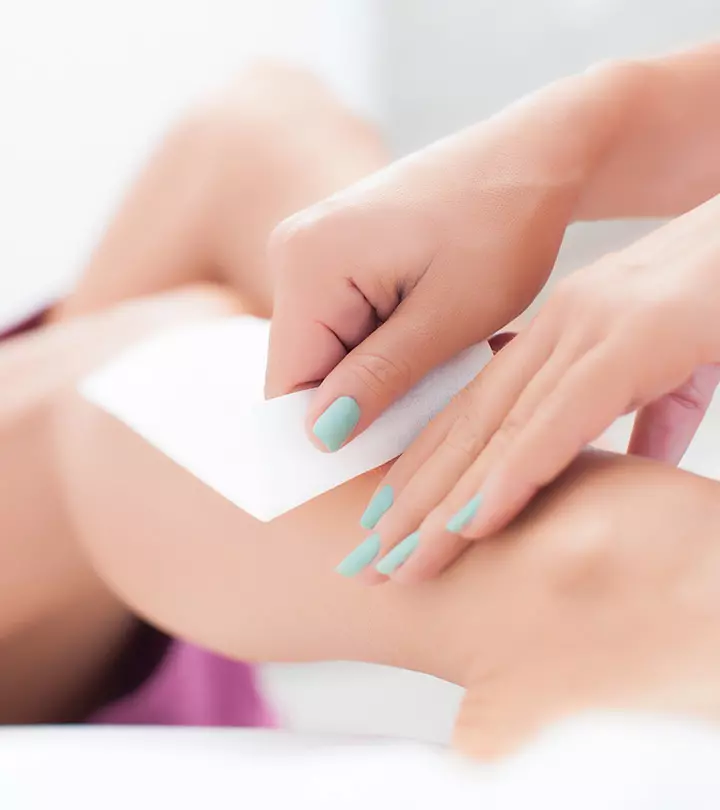
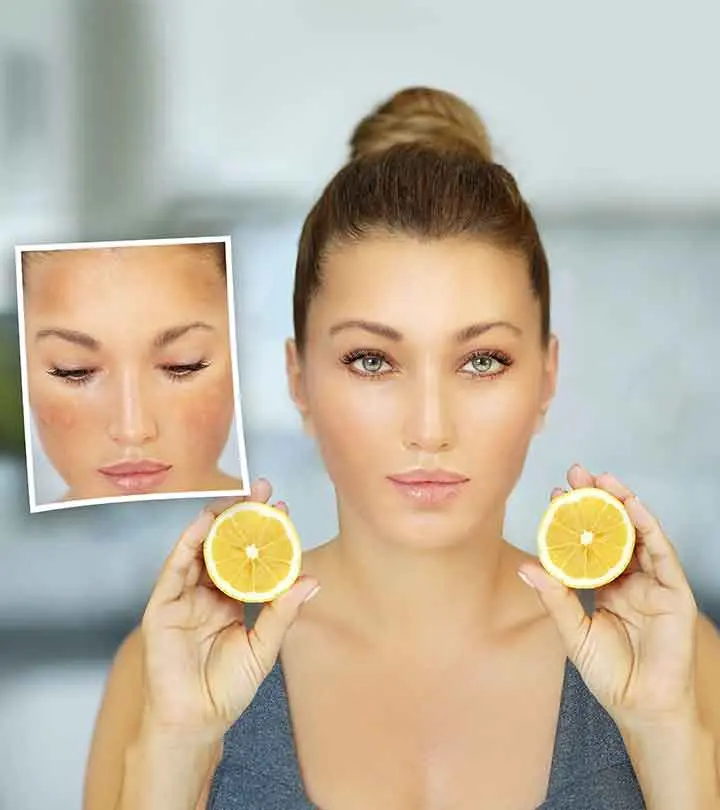



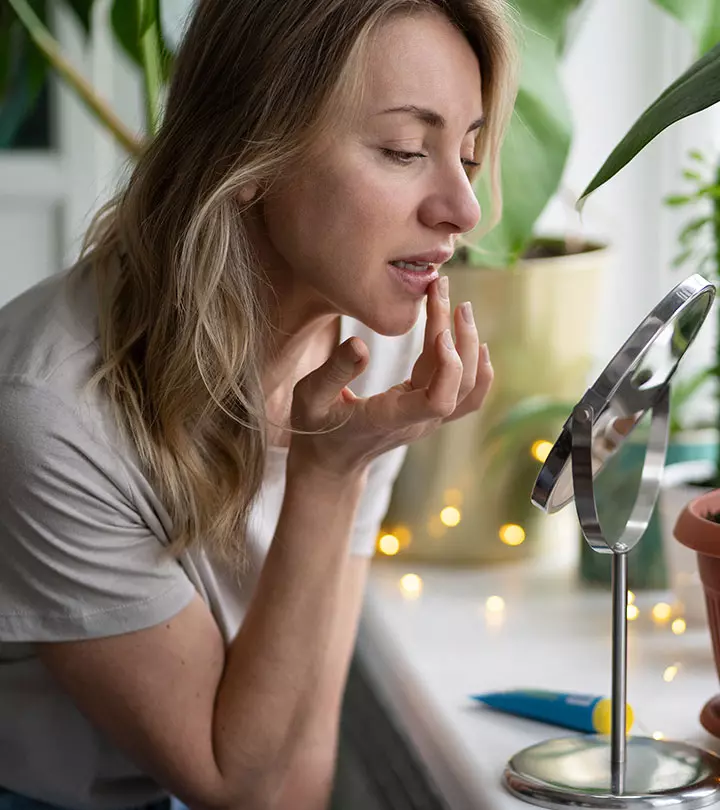


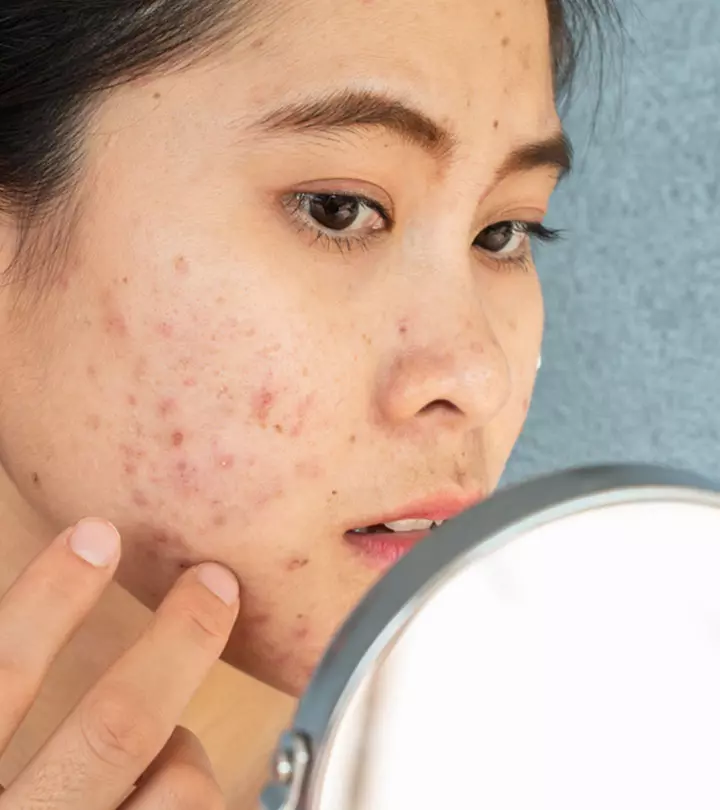

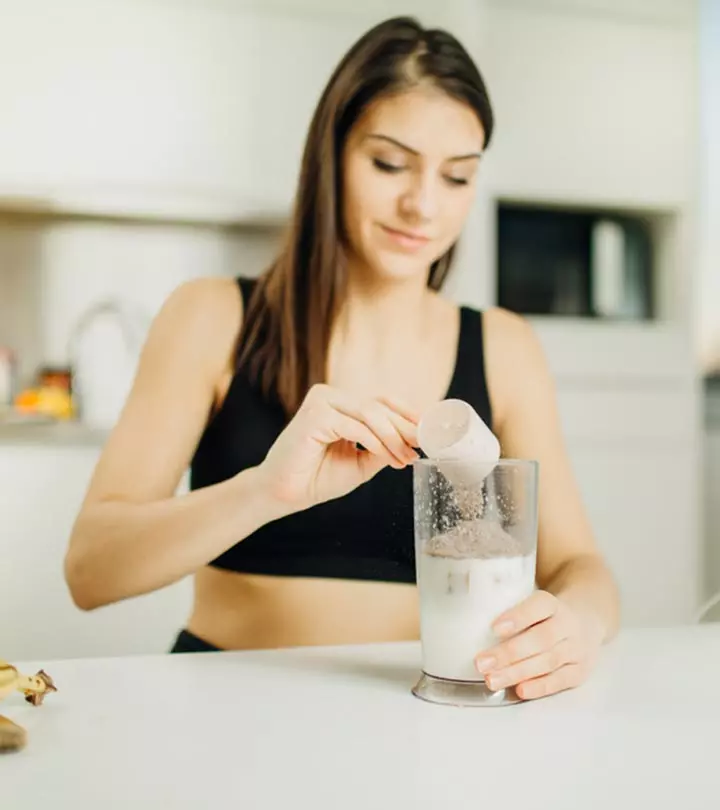

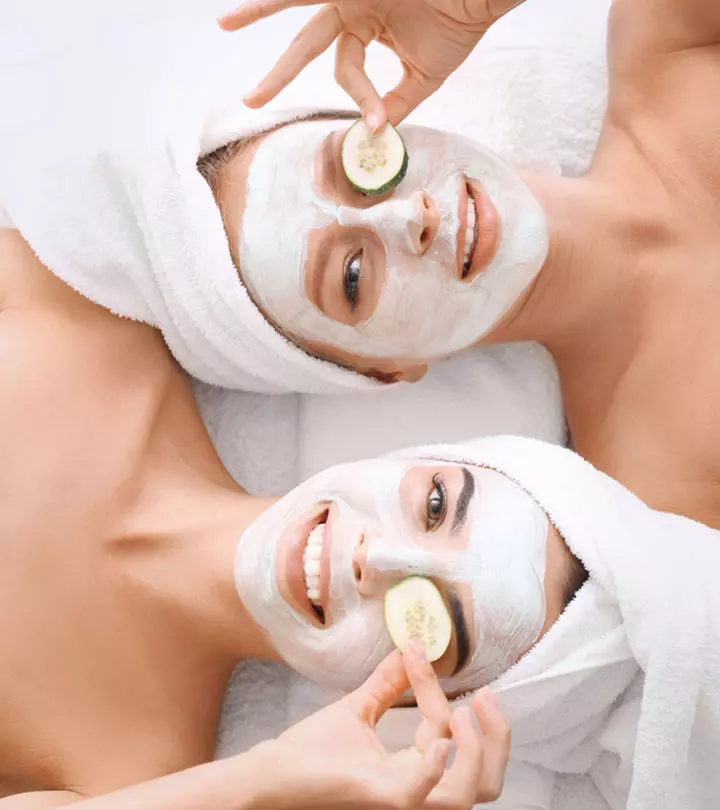




Community Experiences
Join the conversation and become a part of our empowering community! Share your stories, experiences, and insights to connect with other beauty, lifestyle, and health enthusiasts.